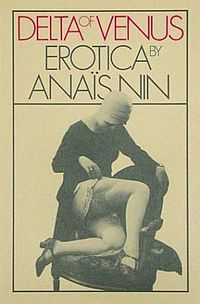Delta of Venus
- For the film adaption, see Delta of Venus (film)
| Delta of Venus | |
|---|---|
 First edition cover art | |
| Author | Anaïs Nin |
| Cover artist |
Milton Glaser Richard Merkin (photo) |
| Country | United States |
| Language | English |
| Genre | Short stories, erotica |
| Publisher | Harcourt Brace Jovanovich |
Publication date | 1977 |
| Media type | Print (Hardback & Paperback) |
| Pages | 250 pp (first edition) |
| ISBN | 0-15-124656-4 |
Delta of Venus is a book of fifteen short stories by Anaïs Nin published posthumously in 1977[1] - though largely written in the 1940s as erotica for a private collector.[2]
In 1995 a film version of the book was directed by Zalman King.
Themes
There are multiple short stories in this work with certain important characters reappearing throughout. In them Nin deals with many different sexual themes, some of them very taboo—including voyeurism,[3] abuse, incest, homosexuality, prostitution, infidelity, and paedophilia—while maintaining the focus of her life's work: the study and description of women.
The stories range in length, and are tied together not just by their sexual premises, but also by Nin's distinct style and feminine viewpoint.
Background
The collection of short stories that makes up this anthology was written during the 1940s for a private client known simply as "Collector"'. This "Collector" commissioned Nin, along with other now well-known writers (including Henry Miller and the poet George Barker), to produce erotic fiction for his private consumption.[4]
Despite being told to leave poetic language aside and concentrate on graphic, sexually explicit scenarios, Nin was able to give these stories a literary flourish and a layer of images and ideas beyond the pornographic. In her Diary (Oct 1941), she jokingly referred to herself as "the madam of this snobbish literary house of prostitution, from which vulgarity was excluded".[5]
While using the Kama Sutra and other writings such as those of Krafft-Ebing as models, Nin was very conscious that the languages of male and female sexuality were distinct.[6] Although at times she scorned her erotica, and feared for their impact on her literary reputation,[7] they have subsequently been seen as pioneering work by sex-positive feminists.[8]
See also
References
- ↑ I. Ousby ed., The Cambridge Guide to Literature in English (1995) p. 683
- ↑
- Anaïs Nin, Delta of Venus & Little Birds (1996) p. 13-16
- ↑ Anne T. Salvatore, Anaïs Nin's narratives, University Press of Florida (2001) ISBN 0-8130-2113-8, p. 31
- ↑
- Anaïs Nin, Delta of Venus & Little Birds (1996) p. 13-16
- ↑
- Anaïs Nin, Delta of Venus & Little Birds (1996) p. 16
- ↑
- Anaïs Nin, Delta of Venus & Little Birds (1996) p. 15 and p. 19
- ↑ Anne T. Salvatore, Anaïs Nin's narratives, University Press of Florida (2001) ISBN 0-8130-2113-8, p. 17
- ↑ Susie Bright, Totally Heterotica (1995) p. 2
Further reading
- Elizabeth Kowaleski-Wallace, Encyclopedia of feminist literary theory, Taylor & Francis, 1997, ISBN 0-8153-0824-8, p. 190
- Andrew Gibson, Postmodernity, ethics and the novel: from Leavis to Levinas, Routledge, 1999, ISBN 0-415-19895-X, p. 177
- Noël Riley Fitch, Anaïs: The Erotic Life of Anaïs Nin (Boston: Little, Brown and Company, 1993) ISBN 0-316-28428-9